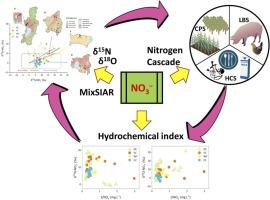利用双同位素追踪和流域尺度氮级联模型量化硝酸盐污染的环境归宿和来源
IF 12.2
1区 环境科学与生态学
Q1 ENGINEERING, ENVIRONMENTAL
引用次数: 0
摘要
河网中的硝酸盐(NO3-)污染已威胁到环境和人类健康。厘清不同底质下流域内 NO3- 的来源和环境归宿对于水体保护,尤其是中国的两条母亲河至关重要。在四个典型流域建立了一系列综合方法,即野外调查、指标测量、同位素示踪技术和物质流分析,以研究 NO3-污染的时空变化和来源以及氮的级联特征。双同位素耦合 MixSIAR 模型显示,在灌溉盆地(WY,76.7%)、丘陵山区盆地(YC,52.3%)和高原湖泊盆地(DC,48.7%),粪便和污水是 NO3-的主要来源。然而,在平原河网流域(CZ),土壤渗滤液是主要来源(55.5%)。就农业环境系统内氮流失到水中的情况而言,三个流域的畜牧业系统(WY,77.3%)、YC(47.3%)和 DC(41.8%)对氮的贡献最大。而在 CZ,约 34.4% 的氮来自作物生产系统。氮级联模型验证了各流域同位素追踪技术的结果。该研究结合水文地质化学指标、同位素示踪技术和物质流分析,为氮氧化物示踪提供了新的视角,并为在流域范围内减轻氮氧化物污染对水生环境的负面影响提供了指导策略。本文章由计算机程序翻译,如有差异,请以英文原文为准。

Quantifying the environmental fate and source of nitrate contamination using dual-isotope tracing coupled with nitrogen cascade model on the basin scale
Nitrate (NO3−) contamination in riverine networks has threatened the environment and human health. Clarifying the NO3− source and environmental fate within the basin under different underlying surfaces is essential for water body protection, especially China's two mother rivers. A series of combination methods were established i.e., field survey, index measurements, isotope-tracing techniques, and material flow analysis in four typical basins to investigate the spatiotemporal variation and source of NO3− pollution and nitrogen cascade characteristics. The dual-isotope coupled with MixSIAR model revealed that manure and sewage were the major NO3− source in the irrigation basin (WY, 76.7%), hilly mountainous basin (YC, 52.3%), and plateau lake basin (DC, 48.7%). However, for the plain-river network basin (CZ), soil leachate was the main source (55.5%). In terms of the N losses to water within agri-environment system, livestock-breeding system in three basins made the biggest contribution among the systems, WY (77.3%), YC (47.3%), and DC (41.8%). While in CZ, about 34.4% of N was delivered from the crop-production system. The N cascade model verified the results of isotope-tracing techniques for each basin. The study provides new insight into NO3−-tracing combining hydrogeochemical indicators, isotopic-tracing techniques, and material flow analysis and guides strategies for mitigating the negative impacts of NO3− pollution on aquatic environments on basin scale.
求助全文
通过发布文献求助,成功后即可免费获取论文全文。
去求助
来源期刊

Journal of Hazardous Materials
工程技术-工程:环境
CiteScore
25.40
自引率
5.90%
发文量
3059
审稿时长
58 days
期刊介绍:
The Journal of Hazardous Materials serves as a global platform for promoting cutting-edge research in the field of Environmental Science and Engineering. Our publication features a wide range of articles, including full-length research papers, review articles, and perspectives, with the aim of enhancing our understanding of the dangers and risks associated with various materials concerning public health and the environment. It is important to note that the term "environmental contaminants" refers specifically to substances that pose hazardous effects through contamination, while excluding those that do not have such impacts on the environment or human health. Moreover, we emphasize the distinction between wastes and hazardous materials in order to provide further clarity on the scope of the journal. We have a keen interest in exploring specific compounds and microbial agents that have adverse effects on the environment.
 求助内容:
求助内容: 应助结果提醒方式:
应助结果提醒方式:


